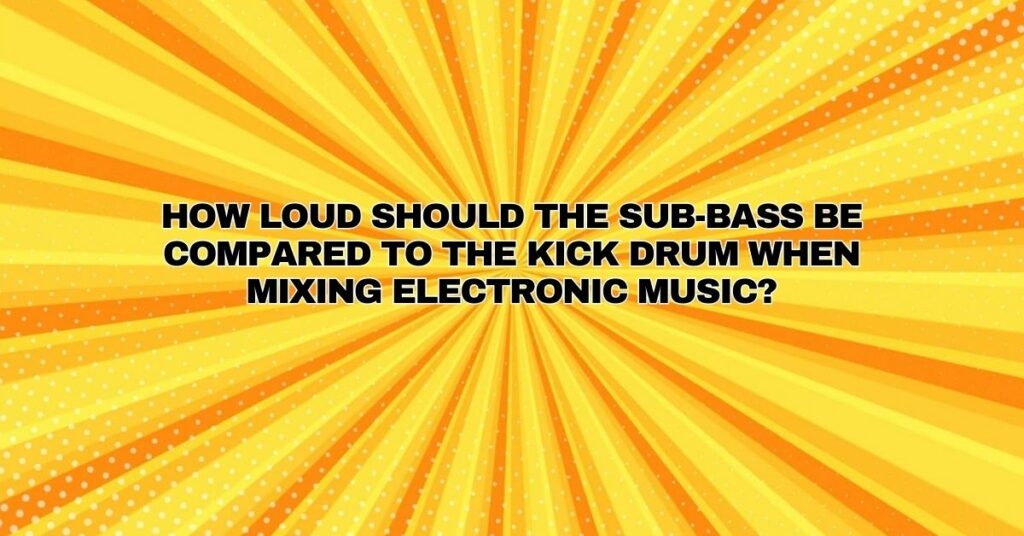In the realm of electronic music, the delicate interplay between the sub-bass and the kick drum is a defining element that shapes the groove, energy, and impact of a track. Achieving the ideal balance between the two is an art that both novice and experienced producers strive to master. In this comprehensive article, we will delve into the intricacies of sub-bass and kick drum balancing in electronic music mixing, discussing the significance of this relationship, factors influencing the balance, and practical techniques to achieve the desired results.
The Dynamic Duo: Sub-Bass and Kick Drum
Sub-bass and kick drum are like the heart and soul of electronic music. Each plays a distinct role:
- Kick Drum: The kick drum, often referred to as the “kick,” provides the rhythmic foundation and pulse of a track. It has a distinct, punchy character, typically residing in the mid-frequency range.
- Sub-Bass: Sub-bass frequencies are the lowest range of audio frequencies, responsible for the deep, resonant, and often visceral elements in electronic music. Sub-bass provides depth, power, and a sense of physicality to the track.
Significance of Sub-Bass and Kick Drum Balancing
Achieving the perfect balance between the sub-bass and kick drum is crucial for several reasons:
- Groove and Rhythm: The synergy between the kick drum and sub-bass is what generates the infectious groove and rhythm that defines electronic music genres. It’s the groove that compels listeners to move and dance.
- Energy and Impact: The balance of the sub-bass and kick drum influences the overall energy and impact of a track. Too much sub-bass can overwhelm the mix, while too little may result in a lack of depth and power.
- Clarity and Definition: Balancing these elements correctly ensures clarity and definition in the mix. A well-balanced kick and sub-bass allow each element to shine without muddying the overall sound.
Factors Influencing the Balance
Several factors influence the balance between the sub-bass and kick drum:
- Genre and Style: The genre and style of electronic music play a significant role in determining the balance. For instance, genres like techno and house music often feature a pronounced, punchy kick drum that takes center stage, while dubstep and trap may prioritize sub-bass.
- Mixing and Production Goals: The artistic intent of the producer also influences the balance. Some tracks may aim for a raw, intense sound with a prominent sub-bass, while others may opt for a cleaner, more controlled mix with a prominent kick drum.
- Listening Environment: The listening environment is essential. In a club or festival setting, where powerful subwoofers are prevalent, the balance may lean more toward the sub-bass. In a home or studio environment, a more balanced approach is often preferred.
Balancing Techniques and Strategies
Achieving the perfect balance between the sub-bass and kick drum requires a combination of techniques and strategies:
- Side-Chain Compression: Side-chain compression is a common technique used to create space for both the kick drum and sub-bass. By side-chaining the sub-bass to the kick drum, you can ensure that the sub-bass volume is momentarily reduced each time the kick drum hits. This creates a dynamic and rhythmic effect that maintains both elements’ prominence.
- EQ and Frequency Shaping: Use EQ to shape the frequencies of both the kick drum and sub-bass. Ensure that they occupy distinct frequency ranges, with the kick drum residing in the mid-range and the sub-bass in the lower frequencies. Subtractive EQ can be used to remove unwanted frequencies that might clash.
- Level Balancing: Experiment with the relative levels of the kick drum and sub-bass. Start by setting the levels of the kick and sub-bass where they are prominent but not overpowering. Then, fine-tune the balance as you progress through the mix.
- Monitor in Context: Continuously monitor the balance in the context of the entire mix. Ensure that the sub-bass and kick drum complement other elements, such as synths, vocals, and percussion. The overall mix should remain coherent and balanced.
Conclusion
Balancing the sub-bass and kick drum in electronic music mixing is an intricate and nuanced process that requires a deep understanding of genre, style, production goals, and listening environments. The dynamic relationship between these two elements is the essence of electronic music’s infectious groove and energy. By applying techniques like side-chain compression, EQ, and level balancing, producers can achieve the desired balance while maintaining clarity, definition, and power in their mixes. The art of striking the perfect balance between the sub-bass and kick drum is a journey that continues to captivate electronic music producers, adding depth and vibrancy to their sonic creations.

